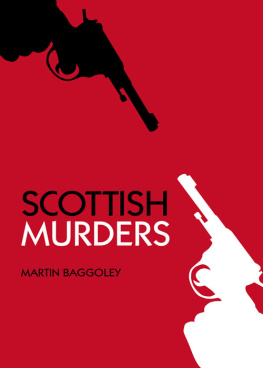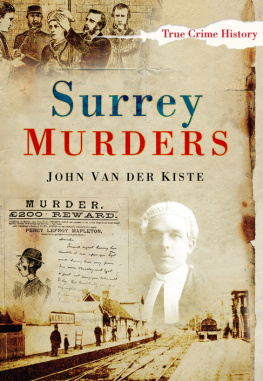Berkshire
MURDERS
JOHN VAN DER KISTE

First published 2010
The History Press
The Mill, Brimscombe Port
Stroud, Gloucestershire, GL5 2QG
www.thehistorypress.co.uk
This ebook edition first published in 2012
All rights reserved
John Van der Kiste, 2011, 2012
The right of John Van der Kiste, to be identified as the Author of this work has been asserted in accordance with the Copyrights, Designs and Patents Act 1988.
This ebook is copyright material and must not be copied, reproduced, transferred, distributed, leased, licensed or publicly performed or used in any way except as specifically permitted in writing by the publishers, as allowed under the terms and conditions under which it was purchased or as strictly permitted by applicable copyright law. Any unauthorised distribution or use of this text may be a direct infringement of the authors and publishers rights, and those responsible may be liable in law accordingly.
EPUB ISBN 978 0 7524 8401 3
MOBI ISBN 978 0 7524 8400 6
Original typesetting by The History Press
CONTENTS
Combe, 1676
Caversham, 1722
Wantage, 1833
Warfield, 1851
Maidenhead, 1852
Wokingham, 1856
Windsor, 1862
Windsor, 1864
Reading, 1864
Newbury, 1866
Hungerford, 1876
Slough, 1881
Chalvey, 1888
Newbury, 1891
Newbury, 1892
Reading, 1896
Reading, 1896
Eton, 1912
Gallows Tree Common, near Pangbourne, 1922
Maidenhead, 1929
Reading, 1929
Maidenhead, 1932
Winkfield, 1939
Maidenhead, 1948
AUTHORS NOTE & ACKNOWLEDGEMENTS
D uring the last three or four centuries Berkshire has witnessed a number of violent killings as savage and appalling, or occasionally downright tragic, as anywhere else in England. There were cases where the murderer committed suicide, one of these involving a widower who poisoned his children (one of whom survived) before doing the same to himself; and a suicide pact which left one partner dead and the other a human wreck, to spend the rest of his life in Broadmoor. There was the murder of a young boy by his insane father; the apparently motiveless slaying of a popular pub landlady by a youth who blamed the influence of the pictures, a chilling forerunner of the effect that video nasties would have on a later generation; the death of a young woman at the hands of her husband, exasperated by her infidelities, whose execution was to be immortalised in Oscar Wildes The Ballad of Reading Gaol; and, perhaps worst of all, the story of the woman now remembered as Englands most notorious baby farmer.
For the twenty-four chapters in this book, a few minor liberties have been taken with the county boundaries of Berkshire. To take one example, the murder of Ann Pullen in 1833 was committed at Wantage in old Berkshire, which, since 1974, has been in Oxfordshire. Conversely, Ann Reville was killed in 1881 in Slough, which was then in Berkshire and is now in Buckinghamshire. I trust readers will accept these small degrees of licence.
Particular thanks are due to my wife Kim for her constant support, encouragement and assistance with reading through the draft manuscript; to Nicola Sly for always being ready with helpful advice and information whenever needed; to Simon Dell MBE; Len Woodley, Berkshire Police Historian of the Police History Society, for special assistance with the Hungerford police murders illustrations; to Mrs Beryl Hedges, Mr R.J. Hunter and Roger Long, for general information; to Kenneth Allen, Terry Bean, Colin Bates, Dr Neil Clifton, Nigel Cox, Peter Land, Brian Marshall, Andrew Smith and R. Sones for permission to reproduce images of copyrighted material; and, as ever, my editors at The History Press, Matilda Richards and Beth Amphlett, for their continued help and encouragement in seeing the book through to publication.
Every effort has been made to obtain permission to reuse material which may be in copyright, and I would be grateful if any holders of relevant material whose rights may have been inadvertently infringed would notify us, so that a suitable correction can be made to subsequent editions.
John Van der Kiste, 2010
1
THE GIBBET ON INKPEN HILL

Combe, 1676

O ne of Berkshires earliest murders took place during the late seventeenth century. Many of the facts are now obscured by the mists of antiquity, but the most commonly given version of events is as follows.
George Broomham, a farmer at West Woodhay, began an affair with Dorothy Newman, a widow who lived at nearby Combe. George was already married, and Martha was a faithful wife, but he had tired of her and fell prey to the charms of Mrs Newman. Divorce in those days was almost unheard of, especially for those outside the nobility who could never even contemplate the expense of such an action. The only way to dispose of an unwanted spouse was by arranging for his or her death, while trying to make it look accidental.
While coming home from work one day, George noticed a wasps nest, realised that this would help him to commit what he believed would be the perfect crime, and made a mental note of the location. A few days later, husband and wife went to market together, and he mentioned the nest. Martha was keen to see it, so George pulled up his pony and trap, and they got out together to have a look. As they did so, George put on a pair of thick leather gauntlets, saying he needed them to pull the brambles aside on their way. While Martha looked at the nest, he crept up behind her, seized her by the shoulders and forced her head into the nest. Taken by surprise, she did not even scream, and as they were miles away from anywhere or anyone else, there would have been no point in trying to raise the alarm. Martha tried to struggle, but her husband was too strong for her, and it was only a matter of time before she was stung to death.
Feeling satisfied with having stage-managed what appeared to be a dreadful accident, George returned to his cart and proceeded on to market. The next day Marthas body was found, and George had no difficulty in playing the role of a grief-stricken widower.
George came close to getting away with murder, but, according to one source, the next time he visited Dorothy Newman, he told her the full story as they sat in her cottage, and were overheard by her son, who pretended to be asleep. The next day he repeated everything to the authorities, who arrested George and took him to Winchester Gaol.
Another version of the story says that both lovers were involved in the killing of Martha Broomham and that she was in fact beaten to death, probably with a staff. They had believed they were alone, but they were seen by the village idiot, Mad Thomas, who went and told the magistrates what he had seen. Yet another version suggests that Robert, the young son of George and Martha, was also killed on the Downs, as his father was determined that nobody would stand in the way of his love affair with Dorothy.
Whatever the truth of the matter, George Broomham was tried and convicted at Winchester Assizes of the wilful murder of his wife on or around 23 February 1676. He was sentenced to be hanged in chains near the site of the murder. Those who say that Dorothy Newman took part in the murder also maintain that she stood in the dock alongside him and shared his fate.





















